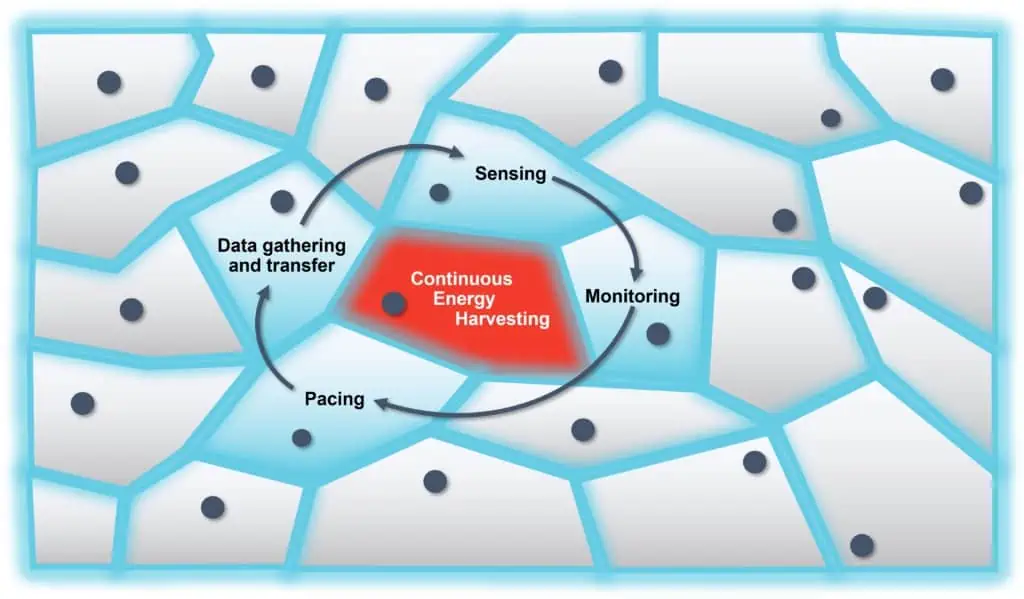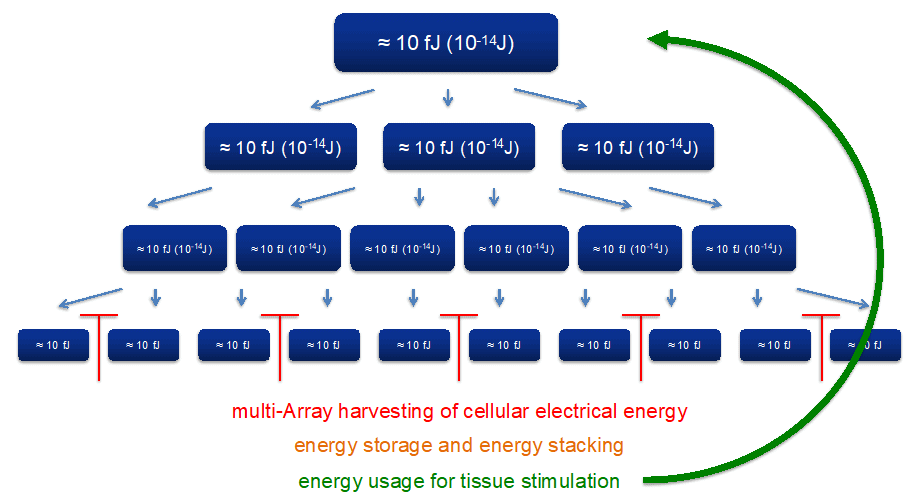
Celtro envisions a leadless pacemaker with continuous energy harvesting driving sensing, monitoring and pacing, as well as data gathering. (Source: Celtro)
By Adele Hars
What’s at stake?
The pacemaker envisioned by Celtro is both leadless and battery-free. The company sees a big market opportunity, but there are miles to go to get there. A prototype is three years away.
Every year, about a million people around the world get a pacemaker implant – and every single one of those implants is battery powered. Celtro, an early-stage startup in Dresden, Germany, aims to create a new generation of pacemakers that run on energy harvested continuously and directly from the biochemical reactions that produce energy in cardiac cells. Following Celtro’s recently announced seed-funding round, the Ojo-Yoshida Report had the opportunity to speak with the CEO, Gerd Teepe.
Ten years ago, a self-powered pacemaker wouldn’t have been possible, but Moore’s Law is working in the company’s favor, says Teepe. The difference is that instead of going for the super high performance pursued for everything from cell phones to supercomputers, Celtro aims to leverage the (very) low-power side of the power/performance trade-off.
Basic pacemaker technology is not new: the first pacemaker debuted in 1958. Pacemakers have gotten steadily smaller and more reliable over the years (a retired electrical engineer in the U.K. holds the Guinness record; he’s had his since 1983). But pacemaker batteries need to be changed about every 10 years, at a cost in the $10,000 range.
Traditional pacemakers – which for the time being means almost all pacemakers – consist of a generator unit that’s implanted in a pocket under the skin below the collarbone, with “leads” (wires) that run to the parts of the heart that control pacing.
Medtronic, which owns 60 percent of the $4 billion market, per GlobalData, is the only player with an FDA-approved (as of 2016) “leadless” pacemaker. Its Micra line comprises a self-contained unit the size of large vitamin pill that attaches directly to the heart (without leads). GlobalData predicts the leadless market will reach a billion dollars by 2029.
(Image: Medtronic)
The pacemaker envisioned by Celtro is both leadless and battery-free. The company sees a big market opportunity, but there are miles to go to get there. A prototype is at least three years out.
The Celtro invention
The Celtro story began in 2019 when Dr. Judith Piorkowski, a Dresden cardiologist and electrophysiologist, was talking with a neighbor, Gerd Teepe, a semiconductor industry veteran who’s held engineering leadership positions at GlobalFoundries, AMD and Motorola/Freescale. Piorkowski, who is also involved with a company called e-heart, which specializes in reviewing, analyzing and providing heart function data, knew what she wanted for her patients: a leadless pacemaker powered by energy harvested in vivo from the heart’s own cells.
From her perspective, you could look at the heart as a big battery, with each of the billions of cells producing electrical and mechanical energy from glucose. Could chip technology be developed that harvested just a tiny fraction that energy – just enough to control pacing as well as handle sensing and data collection? Teepe considered the challenge, then proposed and patented chip technology that would be able to work in the nanowatt range. The patents include a Self-sufficient cardiac pacemaker and Energy generation from tiny sources. Teepe and Piorkowski joined forces with another Dresden cardiologist/electrophysiologist, Dr. Thomas Gaspar and Jarek Budny, a finance expert, to found Celtro. The company claims to have procured key industry partners in the Dresden ecosystem, but declines to say who they are.
Teepe explains that cardiac cells produce a swing of about 100mV of energy from redox: the reduction of glucose with each heartbeat. There are about 10 femtojoules (10-14) of power available per cell. With his inventions, the chip needs to harvest millivolts and transform them into volts, but the energy can be harvested from hundreds of points. Since a heartbeat is initiated in just a few cells and then immediately propagates widely, you quickly have many cells from which to harvest. Once the device transforms the millivolts into volts, it needs to stimulate only one point in the heart. This is a virtuous cycle. While some energy is lost in the conversion, the device always harvests more energy than is needed, and you don’t need much. A few thousand gates is enough to do a pacemaker.

The chip will include a microprocessor that will be software upgradeable.
Teepe concedes that the approach is pushing the envelope for semiconductors. These chips will be operating in nanowatts, which is a factor of 1,000 lower than what is available today. But biological systems are relatively slow, he points out. Compared with today’s processors, which operate in the gigahertz range, a heartbeat is only around a hertz, and nerve speed is around a kilohertz. That’s the range in which Celtro will be operating.
Running down the power curve will not be enough: static and dynamic leakage need to be factored in. But Teepe is confident that the company can solve the technical challenges within three years, at which point it will have a prototype (the development of which is funded by the State of Saxony).
The competition
There are multiple ways to do energy harvesting. For the moment, Celtro seems to be the only company pursuing the biochemical route (the collection of energy from the cellular action potential). Over the last decade others have considered it, but found the energy density to be too low. To overcome this challenge, it’s critical that the Celtro solution operate in the nanowatt range, and harvest energy from hundreds of points at a time.
Other options being pursued by the competition include kinetic/piezoelectric, RF, thermal and even photovoltaic. Teepe sees competitors using the kinetic approach to be Celtro’s closest rivals – and with good reason.
In 2019, a team out of China published a paper in Nature Communications entitled “Symbiotic cardiac pacemaker” that caused quite a stir in the press worldwide. The Chinese team had successfully implanted a pacemaker self-powered by biomechanical energy in a pig – the first such device in a large animal. However, as Dr. Charles Pearman, clinical lecturer in cardiovascular science at the University of Manchester, noted at the time, “the generator that has been tested powered a pacemaker for only one minute after requiring more than an hour’s worth of heartbeats to charge it up. The technology as it stands would therefore need to be significantly more efficient at extracting energy to be useful for those who require their pacemakers to function continuously.”
In 2020, a French company called Cairdac announced that it had developed the world’s first self-sustainable leadless pacemaker, dual-chamber compatible, incorporating an inertial energy harvester capable of providing a renewable power supply to the device at every heartbeat. This development came out of an €8 million European Horizon 2020 program called Smart-MEMPHIS, the goal of which was “to design, manufacture and test innovative miniature-sized electronics components capable of harvesting low-frequency vibrational energy with piezo-MEMS (microelectromechanical system) energy harvesters.” Cairdac plans to complete its product development and market validation by 2025.
And of course, the market leaders are not sitting still. Medtronic itself participated in a €6 million European Horizon 2020 program called Manpower led by the Tyndall Institute, aiming to “facilitate extraction and storage of energy from a beating heart to power a pacemaker.”
Meanwhile, the battery-operated leadless market is just getting off the ground, and Medtronic’s competitors are hot on its heels. Medtronic’s Micra leadless pacemaker got FDA approval five years ago, while Boston Scientific and Abbott Aveir now have leadless pacemakers undergoing the FDA approval process.
Even FDA approval is no sure ticket to success. St. Jude Medical (now part of Abbott) had a leadless pacemaker called Nanostim approved around the same time as Medtronic’s Micra. But St. Jude had to quickly and, ultimately, irrevocably pull it from the market due to concerns over battery leakage.
The Celtro time line calls for just three years to develop the prototype and another three years for regulatory approval. Will that be enough? Teepe says their investors take the long view. “You have to choose the right moment,” concludes Teepe. “It’s the right moment.”
Conclusion
Celtro faces a number of hurdles, technological and regulatory, before its leadless, battery-free pacemaker becomes a reality. But if it comes to fruition, the company’s biochemical approach to energy harvesting holds great potential for the $4 billion pacemaker market.
Adele Hars, an American who has lived in France for the better part of 30 years, is an experienced technology journalist who recently finished a 15-year run as editor-in-chief at SOI News. She is a contributing editor for The Ojo-Yoshida Report.
Copyright permission/reprint service of a full Ojo-Yoshida Report story is available for promotional use on your website, marketing materials and social media promotions. Please send us an email at [email protected] for details.
